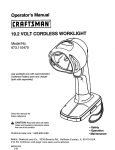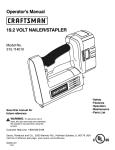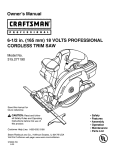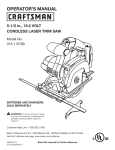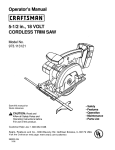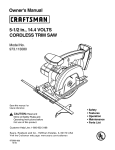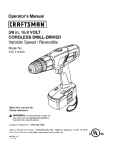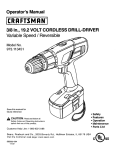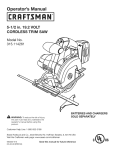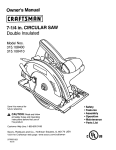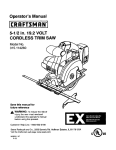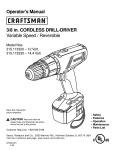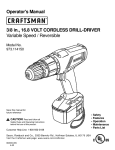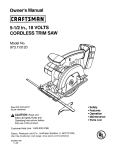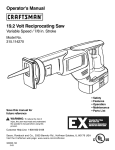Download Craftsman 973.112930 Operator`s manual
Transcript
Operator's Manual 5-1/2 in. 19.2 VOLT CORDLESS TRIM SAW Model No. 973.112930 Save this manual for future reference • • • • • • _I= CAUTION: Read and follow all Safety Rules and Operating Instructions before first use of this product. Customer Help Line: 1-800-932-3188 Sears Roebuck and Co., 3333 Beverly Rd. Hoffman visit the Craftsman web page: www.sears.com/craftsman 983000-002 2-02 Estates, IL 60179 USA Safety Features Assembly Operation Maintenance Parts List 0( us • Table Of Contents and Warranty ................................................................................................................................ • Introduction and General Safety Rules .................................................................................................................... 3-4 • Specific Safety Rules and Symbols ......................................................................................................................... 4-7 • Product Specifications, • Features ................................................................................................................................................................ 8-10 • Assembly .............................................................................................................................................................. 11-12 • Operation ............................................................................................................................................................. 13-20 • Maintenance • Exploded ViewAnd • Parts Ordering/Service Unpacking, and Accessories ................................................................................................. ............................................................................................................................................................. Repair Parts List .................................................................................................................. ........................................................................................................................................... FULL ONE YEAR WARRANTY 2 8 21 22-23 24 ON CRAFTSMAN CORDLESS TRIM SAW If this CRRFTSMAN Cordless Trim Saw fails to give complete satisfaction within one year from the date of purchase, RETURN IT TO THE NEAREST SEARS STORE OR SEARS SERVICE CENTER IN THE UNITED STATES, and Sears will repair it, free of charge. If this [RRFTTMRN Cordless Trim Saw is used for commercial from the date of purchase. or rental purposes, this warranty applies for only 90 days This warranty gives you specific legal rights, and you may also have other rights which vary from state to state. Sears, Roebuck and Co., Dept. 817WA, Hoffman Estates, IL 60179 _I, Look for this symbol to point out important involved. safety precautions. It means attention!!! Your safety is _1= WARNING: The operation of any power tool can result in foreign objects being thrown into your eyes, which can result in severe eye damage. Before beginning power tool operation, always wear safety goggles or safety glasses with side shields and a full face shield when needed. We recommend Wide Vision Safety Mask for use over eyeglasses or standard safety glasses with side shields, available at Sears Retail Stores. Always wear eye protection which is marked to comply with ANSI Z87.1. SAFETY AND INTERNATIONAL SYMBOLS This operator's manual describes safety and international symbols and pictographs that may appear on this product. Read the operator's manual for complete safety, assembly, operating and maintenance, and repair information. MEANING Do not expose to rain or use in damp locations. 2 Yourtrimsawhasmanyfeaturesformakingyourcutting operations morepleasantandenjoyable.Safety, performance anddependability havebeengiventop priorityinthedesignof thistrimsawmakingiteasyto maintainandoperate. H WARNING: Read and follow all instructions. Failure to follow all instructions listed below, may result in electric shock, fire and/or serious personal injury. SAVE THESE CAUTION:Carefullyreadthroughthisentire operator'smanualbeforeusingyournewtrimsaw. PaycloseattentiontotheGeneralSafetyRules, SpecificSafetyRules,Symbols, Warnings, and Cautions.If youuseyourtrimsawproperlyandonly forit'sintendeduse,youwillenjoyyearsofsafe, reliableservice. Personal • • Keep your work area clean and well lit. Cluttered benches and dark areas invite accident. • Do not operate power tools in explosive atmospheres, such as in the presence of flammable liquids, gases, or dust. Power tools create sparks which may ignite the dust or fumes. • • Dress properly. Do not wear loose clothing or jewelry. Contain long hair. Keep your hair, clothing, and gloves away from moving parts. Loose clothes, jewelry, or long hair can be caught in moving parts. • Avoid accidental starting. Be sure switch is in the locked or off position before inserting battery pack. Carrying tools with your finger on the switch or inserting the battery pack into a tool with the switch on invites accidents. • Remove adjusting keys or wrenches before turning the tool on. A wrench or a key that is left attached to a rotating part of the tool may result in personal injury. • Do not overreach. Keep proper footing and balance at all times. Proper footing and balance enable better control of the tool in unexpected situations. • Use safety equipment. Always wear eye protection. Dust mask, nonskid safety shoes, hard hat, or hearing protection must be used for appropriate conditions. Keep bystanders, children, and visitors away while operating a power tool. Distractions can cause you to lose control. Electrical Safety • Do not abuse the cord. Never use the cord to carry the charger. Keep cord away from heat, oil, sharp edges, or moving parts. Replace damaged cords immediately. Damaged cords may create a fire. A battery operated tool with integral batteries or a separate battery pack must be recharged only with the specified charger for the battery. A charger that may be suitable for one type of battery may create a risk of fire when used with another battery. Use battery only with charger listed. MODEL BATTERY PACK CHARGER 973.112930 Item No. _9-11375 (1310715) Stay alert, watch what you are doing and use common sense when operating a power tool. Do not use tool while tired or under the influence of drugs, alcohol, or medication. A moment of inattention while operating power tools may result in serious personal injury. INSTRUCTIONS Work Area • Safety Tool Use and Care • Use clamps or other practical way to secure and support the workpiece to a stable platform. Holding the work by hand or against your body is unstable and may lead to loss of control. • Do not force tool. Use the correct tool for your application. The correct tool will do the job better and safer at the rate for which it is designed. Item No. 9-11041 (1425301 ) Use battery operated tool only with specifically designated battery pack. Use of any other batteries may create a risk of fire. Use only with battery pack listed. • Do not use tool if switch does not turn it on or off. A tool that cannot be controlled with the switch is dangerous and must be repaired. • • • • Disconnect battery pack from tool or place the switch in the locked or off position before making any adjustments, changing accessories, or storing tool. Such preventive safety measures reduce the risk of starting the tool accidentally. Check for misalignment or binding of moving parts, breakage of parts, and any other condition that may affect the tool's operation. If damaged, have the tool serviced before using. Many accidents are caused by poorly maintained tools. • Store idle tools out of the reach of children and other untrained persons. Tools are dangerous in the hands of untrained users. Use only accessories that are recommended by the manufacturer for your model. Accessories that may be suitable for one tool, may create a risk of injury when used on another tool. Service • Tool service must be performed by qualified repair personnel. Service or maintenance performed by unqualified personnel may result in a risk of injury. • When servicing a tool, use only identical replacement parts. Follow instructions in the Maintenance section of this manual. Use of unauthorized parts or failure to follow Maintenance Instructions may create a risk of shock or injury. When battery pack is not in use, keep it away from other metal objects like: paper clips, coins, keys, nails, screws, or other small metal objects that can make a connection from one terminal to another. Shorting the battery terminals together may cause sparks, burns, or a fire. • Maintain tools with care. Keep cutting tools sharp and clean. Properly maintained tools with sharp cutting edges are less likely to bind and are easier to control. Hold tool by insulated gripping surfaces when performing an operation where the cutting tool may contact hidden wiring. Contact with a "live" wire will make exposed metal parts of the tool "live" and shock the operator. Additional • • Know your power tool. Read operator's manual carefully. Learn its applications and limitations, as well as the specific potential hazards related to this tool. Following this rule will reduce the risk of electric shock, fire, or serious injury. _, Make sure your extension cord is in good condition. When using an extension cord, be sure to use one heavy enough to carry the current your product will draw. A wire gage size (A.W.G.) of at least 16 is recommended for an extension cord 100 feet or less in length. A cord exceeding 100 feet is not recommended. If in doubt, use the next heavier gage. The smaller the gage number, the heavier the cord. An undersized cord will cause a drop in line voltage resulting in loss of power and overheating. Important • • Rules For Safe Operation Do not place battery tools or their batteries near fire or heat. This will reduce the risk of explosion and possible injury. WARNING: Batteries vent hydrogen gas and can explode in the presence of a source of ignition, such as a pilot light. To reduce the risk of serious personal injury, never use any cordless product in the presence of open flame. An exploded battery can propel debris and chemicals. If exposed, flush with water immediately. Do not charge battery tool in a damp or wet location. Following this rule will reduce the risk of electric shock, fire, or serious personal injury. Your battery tool should be charged in a location where the temperature is more than 50°F but less than IO0°F. Following this rule will reduce the risk of electric shock, fire, or serious personal injury. Rules For Battery Tools Battery tools do not have to be plugged into an electrical outlet; therefore, they are always in operating condition. Be aware of possible hazards when not using your battery tool or when changing accessories. Under extreme usage or temperature conditions, battery leakage may occur. If liquid comes in contact with your skin, wash immediately with soap and water, then neutralize with lemon juice or vinegar. If liquid gets into your eyes, flush them with clean water for at least 10 minutes, then seek immediate medical attention. Following this rule will reduce the risk of serious personal injury. 4 Additional Specific Safety Rules • DANGER! Keep hands away from cutting area and blade. Keep your second hand on auxiliary handle or motor housing. If both hands are holding the saw, they cannot be cut by the blade. Keep your saw blade, KICKBACK See Pages body positioned to either side of the but not in line with the saw blade. could cause the saw to jump backwards. 14 and 15. • Do not reach underneath the work. The guard cannot protect you from the blade below the work. • Check the lower guard for proper closing before each use. Do not operate saw if lower guard does not move freely and close instantly. Never clamp or tie the lower guard into the open position. If saw is accidentally dropped, lower guard may be bent. Raise the lower guard with the retracting handle and make sure it moves freely and does not touch the blade or any other part, in all angles and depths of cut. • Never use damaged or incorrect blade washers or bolts. The blade washers and bolt were specially designed for your saw, for optimum performance and safety of operation. • Kickback is a sudden reaction to a pinched, bound, or misalignsd saw blade, causing an uncontrolled saw to lift up and out of the workpiece toward the operator. When the blade is pinched or bound tightly by the kerf closing down, the blade stalls and the motor reaction drives the unit rapidly back toward the operator. If the blade becomes twisted or misaligned in the cut, the teeth at the back edge of the blade can dig into the top surface of the wood causing the blade to climb out of the kerr and jump back toward the operator. Kickback is a result of tool misuse and/or incorrect operating procedures or conditions and can be avoided by taking proper precautions as given below: Check the operation and condition of the lower guard spring. If the guard and the spring are not operating properly, they must be serviced before use. Lower guard may operate sluggishly due to damaged parts, gummy deposits, or a buildup of debris. • Lower guard should be retracted manually only for special cuts such as "Pocket Cuts" and "Compound Cuts". Raise lower guard by Retracting Handle. As soon as blade enters the material, lower guard must be released. For all other sawing, the lower guard should operate automatically. • Always observe that the lower guard is covering the blade before placing saw down on bench or floor. An unprotected, coasting blade will cause the saw to walk backwards, cutting whatever is in its path. Be aware of the time it takes for the blade to stop after switch is released. Maintain a firm grip on the saw and position your body and arm in a way that allows you to resist KICKBACK forces. KICKBACK forces can be controlled by the operator, if proper precautions are taken. When blade is binding, or when interrupting a cut for any reason, release the trigger and hold the saw motionless in the material until the blade comes to a complete stop. Never attempt to remove the saw from the work or pull the saw backward while the blade is in motion or KICKBACK may occur. Investigate and take corrective actions to eliminate the cause of blade binding. When restarting a saw in the workpiece, center the saw blade in the kerf and check that teeth are not engaged into the material. If saw blade is binding, it may walk up or KICKBACK from the workpiece as the saw is restarted. NEVER hold piece being cut in your hands or across your leg. It is important to support the work properly to minimize body exposure, blade binding, or loss of control. • Hold tool by insulating gripping surfaces when performing an operation where the cutting tool may contact hidden wiring. Contact with a "live" wire will also make exposed metal parts of the tool "live" and shock the operator. • When ripping always use a rip fence for a straight edge guide. This improves the accuracy of cut and reduces the chance of blade binding. • Always use blades with correct size and shape (diamond vs. round) arbor holes. Blades that do not match the mounting hardware of the saw will run eccentrically, causing loss of control. Causes and Operator Prevention of Kickback: Ill Support large panels to minimize the risk of blade pinching and KICKBACK. Large panels tend to sag under their own weight. Supports must be placed under the panel on both sides, near the line of cut and near the edge of the panel. • Do not use dull or damaged blade. Unsharpened or improperly set blades produce narrow kerr causing excessive friction, blade binding, and KICKBACK. • Blade depth and bevel adjusting locking levers must be tight and secure before making cut. If blade adjustment shifts while cutting, it will cause binding and KICKBACK. Use extra caution when making a "Pocket Cut" into existing walls or other blind areas. The protruding blade may cut objects that can cause KICKBACK. 5 _, • WARNING: Never use a battery that has been dropped or received a sharp blow. A damaged battery is subject to explosion. Properly dispose of a dropped battery immediately. Failure to heed this warning can result in serious personal injury. Do not operate charger with a damaged cord or plug. If damaged, have replaced immediately by a qualified serviceman. Following this rule will reduce the risk of electric shock, fire, or serious personal injury. • • Do not operate charger if it has received a sharp blow, been dropped, or otherwise damaged in any way; take it to a qualified serviceman. Following this rule will reduce the risk of electric shock, fire, or Save these instructions. This manual contains important safety and operating instructions for charger. Following this rule will reduce the risk of electric shock, fire, or serious personal injury. • serious personal injury. Before using battery charger, read all instructions and cautionary markings in this manual, on battery charger, and product using battery charger. Following this rule will reduce the risk of electric shock, fire, or serious personal injury. _LCAUTION: To reduce risk of injury, charge only nickel-cadmium and nickel metal hydride type rechargeable batteries. Other types of batteries may burst causing personal injury and damage. Following this rule will reduce the risk of electric shock, fire, or serious personal injury. • • • • Do not disassemble charger; take it to a qualified serviceman when service or repair is required. Incorrect reassembly may result in a risk of electric shock or fire. Following this rule will reduce the risk of electric shock, fire, or serious personal injury. • To reduce the risk of electric shock, unplug charger from outlet before attempting any maintenance or cleaning. Turning off controls will not reduce this risk. Following this rule will reduce the risk of electric shock, fire, or serious personal injury. • Do not use charger outdoors. Following this rule will reduce the risk of electric shock, fire, or serious Do not expose charger to rain or snow. Following this rule will reduce the risk of electric shock, fire, or personal injury. • serious personal injury. • • Use of an attachment not recommended or sold by the battery charger manufacturer may result in a risk of fire, electric shock, or injury to persons. Following this rule will reduce the risk of electric shock, fire, or serious personal injury. Disconnect charger from power supply when not in use. Following this rule will reduce the risk of electric shock, fire, or serious personal injury. ,_ DANGER: RISK OF ELECTRIC SHOCK. DO NOT TOUCH UNINSULATED PORTION OF OUTPUT CONNECTOR OR UNINSULATED BATTERY TERMINAL. To reduce the risk of damage to charger body and cord, pull by charger plug rather than cord when disconnecting charger. Following this rule will reduce the risk of serious personal injury. • Make sure cord is located to that it will not be stepped on, tripped over, or otherwise subjected to damage or stress. Following this rule will reduce the risk of serious personal injury. An extension cord should not be used unless absolutely necessary. Use of improper extension cord could result in a risk of fire and etectric shock. If extension cord must be used, make sure: Save these instructions. Refer to them frequently and use them to instruct others who may use this tool. If you loan someone this tool, loan them these instructions also. Following this rule will reduce the risk of electric shock, fire, or serious personal injury. _LWARNING: Some dust created by power sanding, sawing, grinding, drilling, and other construction activities contains chemicals known to cause cancer, birth defects or other reproductive harm. Some examples of these chemicals are: a. That pins on plug of extension cord are the same number, size and shape as those of plug on charger. • lead from lead-based b. That extension cord is properly wired and in good electrical condition; and • arsenic and chromium treated lumber. • crystalline silica from bricks and cement and other masonry products, and c. That wire size is large enough forAC ampere rating of charger as specified below: Cord Length (Feet) 25" 50" 100" Cord Size (AWG) 16 16 16 paints, from chemically- Your risk from these exposures varies, depending on how often you do this type of work. To reduce your exposure to these chemicals: work in a well ventilated area, and work with approved safety equipment, such as those dust masks that are specially designed to filter out microscopic particles. Note: AWG = American Wire Gage SAVETHESEINSTRUCTIONS 6 Important: Some of the following symbols may be used on your tool. Please study them and learn their meaning. Proper interpretation of these symbols will allow you to operate the tool better and safer. SYMBOL NAME DESIGNATION/EXPLANATION V Volts Voltage A Amperes Current Hz Hertz Frequency (cycles per second) min Minutes Time Alternating Current Type or a characteristic of current Direct Current Type or a characteristic of current no No Load Speed Rotational speed, at no load .../min Revolutions or Reciprocation ,_ Safety Alert Symbol Per Minute Revolutions, strokes, surface speed, orbits etc. per minute Indicates danger, warning or caution. It means attention!!! Your safety is involved. The purpose of safety symbols is to attract your attention to possible dangers. The safety symbols, and the explanations with them, deserve your careful attention and understanding. The safety warnings do not by themselves eliminate any danger. The instructions or warnings they give are not substitutes for proper accident prevention measures. SYMBOL MEANING A A A A SAFETY NOTE: ALERT SYMBOL: Indicates danger, warning, or caution. May be used in conjunction with other symbols or pictographs. DANGER: Failure to obey a safety warning will result in serious injury to yourself or to others. Always follow the safety precautions to reduce the risk of fire, electric shock and personal injury. WARNING: Failure to obey a safety warning can result in serious injury to yourself or to others. Always follow the safety precautions to reduce the risk of fire, electric shock and personal injury. CAUTION: Failure to obey a safety warning may result in property damage or personal injury to yourself or to others. Always follow the safety precautions to reduce the risk of fire, electric shock and personal injury. Advises you of information or instructions vital to the operation or maintenance of the equipment. 7 TRIM SAW 973.112930 Blade Diameter 5-1/2 in. Blade Arbor 1-9/16 in. Cutting Depth at 45 ° 1-1/8 in. No load Speed 120 v, 60 Hz, AC only 7.2 - 24 Volts t Hour Charge Rate BATrERY PACK ITEM NO. 9_11375 (1310715) 19.2 Volt DC Your trim saw has been shipped completely assembled except for the blade. Inspect it carefully to make sure no breakage or damage has occurred during shipping. If any parts are damaged or missing, contact your nearest Sears Retail Store to obtain replacement parts before attempting to operate saw. A blade, blade wrench (5 mm hex key), rip guide (edge guide) and this operator's manual are also included. The following recommended ,_ WARNING: If any parts are missing, do not operate your saw until the missing parts are replaced. Failure to do so could result in possible serious personal injury. accessories are currently available at Sears Retail Stores. 5-1/2 in. Thin Kerf Blade WARNING: The use of attachments or accessories not listed might be hazardous. KNOW YOUR TRIM SAW See Figure 1. Before attempting to use your trim saw, familiarize yourself with all operating features and safety requirements. Features include easily operated bevel cut and depth of cut adjustment mechanisms; positive 0 ° bevel stop; spindle lock; and blade wrench storage. ,_ ITEM NO. 9 11041 (1425301) Charging Voltage 4,500 RPM Motor _lb Input 318 in. Cutting Depth at 90 ° • CHARGER WARNING: Do not allow familiarity with your saw to make you careless. Remember that a careless fraction of a second is sufficient to inflict severe injury. SWITCH Your saw is equipped with a lock-off button which reduces the possibility of accidental starting. The lock-off button is located on the handle above the switch trigger. You must depress the lock-off button in order to pull the switch trigger. The lock resets each time the trigger is released. Note: You can depress the lock-off button from either the left or right side. APPLICATIONS (Use only for the purposes listed below) • Cutting all types of wood products (lumber, plywood, paneling). LOCK-OFF SPINDLE LOCK BUTTON BUTTON BATrERY PACK SWITCH TRIGGER RIP GUIDESCREW (WINGSCREW) UPPER BLADEGUARD LOWERBLADE GUARDHANDLE LOWER BLADEGUARD BEVELCUTADJUSTMENT (BEVELADJUSTMENTKNOB) BLADE BASE ASSEMBLY RIP GUIDE BLADEW_ STORAG_ BLADEWRENCH (5 mm HEX KEY) DEPTHOF CUTADJUSTMENT (DEPTHADJUSTMENTKNOB) Fig. 1 LED FUNCTION MOUNTING CHARGER See Figure3. OF CHARGER YELLOWANDGREENLEDSON INDICATESDEEPLY DISCHARGEDOR DEFECTIVEBATTERYPACK. CHARGER Your charger has a "key hole" hanging feature for convenient, space saving storage. Therefore, if desired, you can mount your charger to a wall. Screws should be installed so that center distances are 4-1/2 inches apart. REDLED ON INDICATES FASTCHARGINGMODE 4-I/2 in. GREENLEDON AFTERFASTCHARGING CYCLE,INDICATESFULLYCHARGEDBATTERY PACKANDIN TRICKLECHARGEMODE. Fig, 2 BACKSIDEOF CHARGER 10 Fig. 3 _L SPINDLE LOCKBUTTON WARNING: Always remove battery pack from your saw when you are assembling parts, making adjustments, assembling or removing blades, cleaning, or when not in use. Removing battery pack will prevent accidental starting that could cause serious personal injury. LOWERBLADE GUARDHANDLE Note: Your saw is assembled with the battery pack attached. BLADE TO REMOVE BATTERY PACK See Figure 4. • Locate latches on side of battery pack and depress to release battery pack from your saw. See Figure 4. • Remove battery pack from your saw. DEPRESSLATCHESTO RELEASEBATTERYPACK TO REMOVE LADEWASHER OUTER BLADEWASHER BLADESCREW Fig. 5 TO INSTALL LATCHES BAI'I'ERYPACK • Remove blade wrench (5 mm hex key) from storage area. See Figure 1. • Depress spindle lock button and remove blade screw and outer blade washer. See Figure 5. Note: Turn blade screw clockwise to remove. • Wipe a drop of oil onto inner blade washer and outer blade washer where they contact blade. u Fig. 4 TO ASSEMBLE OR REMOVE BLADE • TO ASSEMBLE BLADE: WARNING: A 5-1/2 in. blade is the maximum blade capacity of your saw. Never use a blade that is too thick to allow outer blade washer to engage with the flats on the spindle. Larger blades will come in contact with the blade guard, while thicker blades will prevent blade screw from securing blade on spindle. Either of these situations could result in a serious accident. _ll • Fit saw blade inside lower blade guard and onto spindle. Note: The saw teeth point upward at the front of saw as shown in figure 5. See Figure 5. • WARNING: If inner blade washer has been removed, replace it before placing blade on spindle. Failure to do so could cause an accident since blade will not tighten properly. • Replace outer blade washer. • Depress spindle lock button, then replace blade screw. Tighten blade screw securely. Note: Turn blade screw counterclockwise • to tighten. Return blade wrench to storage area. REMEMBER: Never use a blade that is too thick to allow the outer blade washer to engage with the flats on the spindle. Remove battery pack from saw. WARNING: Failure to remove battery pack from saw could result in accidental starting causing possible serious personal injury. Locate latches on side of battery pack and depress to release battery pack from your saw. See Figure 4. 11 TO REMOVE BLADE TO INSTALL See Figure 6. See Figure 7, • Note: Battery pack is shipped in a low charge condition. Therefore, it must be charged prior to use. Refer to page 13, "CHARGING BATTERY PACK" for charging instructions. Remove battery pack from saw. WARNING: Failure to remove battery pack from saw could result in accidental starting causing possible serious personal injury. • Remove blade wrench from storage area. See Figure 1. • Position saw as shown in figure 6, depress spindle lock button, and remove blade screw. Note: Turn blade screw clockwise to remove. • BA'n'ERY PACK • Place battery pack in your saw. Align raised rib on battery pack with groove inside saw, then slide battery pack in saw as shown in figure 7. • Make sure the latches on each side of your battery pack snap into place and battery pack is secured in saw before beginning operation. Remove outer blade washer. See Figure 5. Note: Blade can be removed at this point. DEPRESSSPINDLE LOCKBuTroN LATCHES TO LOOSEI BATTERYPACK SCREW \ \ Fig. 7 BLADE WRENCH _l, TO TIGHTEN Fig. 6 12 CAUTION: When placing battery pack in your saw, be sure raised rib on battery pack aligns with groove inside saw and latches snap into place properly. Improper assembly can cause damage to saw and battery pack. ,_ • Press down on battery pack to be sure contacts on battery pack engage properly with contacts in charger. • Normally, the red LED on charger will come on. This indicates charger is in fast charging mode. • Red LED should remain on for approximately 1 hour then the green LED will come on. Green LED on indicates battery pack is fully charged and charger is in trickle charge mode. Note: Green LED will remain on until battery pack is removed from charger or charger is disconnected from power supply. • If both yellow and green LED come on, this indicates a deeply discharged or defective battery pack. WARNING: Always wear safety goggles or safety glasses with side shields when operating tools. Failure to do so could result in objects being thrown into your eyes, resulting in possible serious injury. CHARGING BATTERY PACK The battery pack for this tool has been shipped in a low charge condition to prevent possible problems. Therefore, you should charge it until light on front of charger changes from red to green. Note: Batteries will not reach full charge the first time they are charged. Allow several cycles (cutting followed by recharging) for them to become fully charged. Allow battery pack to remain in charger for 15 to 30 minutes. When battery pack reaches normal voltage range, red LED should come on. TO CHARGE • Charge battery pack only with the charger provided. • Make sure power supply is normal house voltage, 120 volts, 60 Hz, AC only. • Connect charger to power supply. • Place battery pack in charger aligning raised rib on battery pack with groove in charger. See Figure 8. If red LED does not come on after 30 minutes, this indicates a defective battery pack and should be replaced. BATTERYPACK SHOWNIN CHARGER • After normal usage, 1 hour of charging time is required to be fully charged. • The battery pack will become slightly warm to the touch while charging. This is normal and does not indicate a problem. • Do not place charger in an area of extreme heat or cold. It will work best at normal room temperature. Note: Charger and battery pack should be placed in a location where the temperature is more than 5O°F but less than 100°F. • CHARGER When the batteries become fully charged, unplug your charger from power supply and remove the battery pack. RED LEDON INDICATES MODE GREEN LEDON AFTERFASTCHARGING CYCLE,INDICATESFULLYCHARGEDBATTERY PACKAND IN TRICKLECHARGEMODE. YELLOWANDGREENLEDSON INDICATESDEEPLY DISCHARGEDOR DEFECTIVEBATI'ERYPACK. Fig. 8 LED FUNCTIONS OF CHARGER LED WILL BE ON TO INDICATE STATUS OF CHARGER AND BATTERY PACK: • Red LED on = Fast Charging Mode. • Green LED on = Fully Charged and in trickle charge mode. 13 • Green LED on = When battery pack is inserted into charger, indicates hot battery pack or that battery pack is out of or below normal temperature range. • Yellow and Green LEDs on = Deeply discharged or defective battery pack. • No LED on = Defective charger or battery pack. _I1 BLADE CAUTION: To prevent damage to battery pack, remove battery pack from charger immediately if no LED comes on. Return battery pack and charger to your nearest Sears Service Center for checking or replacing. Also, if you are removing battery pack from charger and no LEDs are on, return both battery pack and charger to your nearest Sears Service Center. Do not insert another battery pack into charger. A damaged charger may damage a battery pack. IMPORTANT INFORMATION HOT BATTERY PACK FOR GUARD SYSTEM The lower blade guard attached to your trim saw is there for your protection and safety. It should never be altered for any reason. If it becomes damaged or begins to return slow or sluggish, do not operate your saw until the damage has been repaired or replaced. Always leave guard in operating position when using saw. _i, RECHARGING When using your saw continuously, the batteries in your battery pack will become hot. You should let a hot battery pack cool down for approximately 30 minutes before attempting to recharge. When the battery pack becomes discharged and is hot, this will cause the green LED to come on instead of the red LED. After 30 minutes, reinsert battery pack in charger. If green LED continues to remain on, return battery pack to your nearest Sears Repair Center for checking or replacing. Once the battery pack cools down, it will recharge battery pack in fast charging mode as normal. DANGER: When sawing through workpiece, lower blade guard does not cover blade on the underside of workpiece. Since blade is exposed on underside of workpiece, keep hands and fingers away from cutting area. Any part of your body coming in contact with moving blade will result in serious injury. See Figure 9. LOWERBLADEGUARD IS IN UP POSITION WHENMAKINGA CUT Note: This situation only occurs when extreme continuous use of your saw causes the batteries to become hot. It does not occur under normal circumstances. Refer to "CHARGING BA'rI'ERY PACK" for normal recharging of batteries. If the charger does not charge your battery pack under normal circumstances, return both the battery pack and charger to your nearest Sears repair center for electrical check. IMPORTANT INFORMATION COOL BATTERY PACK FOR RECHARGING BLADEEXPOSEDON UNDERSIDEOF WORKPIECE If battery pack is below normal temperature range, the green LED on charger will come on. Allow battery pack to reach normal temperature, then the red LED will come on. Note: Refer to "CHARGING BATTERY PACK" for Fig. 9 Never use saw when guard is not operating correctly. Guard should be checked for correct operation before each use. If you drop your saw, check the lower blade guard and bumper for damage at all depth settings before reuse, Note: The guard is operating correctly when it moves freely and readily returns to the closed position. If for any reason your lower blade guard does not close freely, take it to the nearest Sears Parts and Repair Center for service before using. normal recharging of batteries. If the charger does not charge your battery pack under normal circumstances, return both the battery pack and charger to your nearest Sears Repair Center for electrical check. SAW BLADES The best of saw blades will not cut efficiently if they are not kept clean, sharp, and properly set. Using a dull blade will place a heavy load on your saw and increase the danger of kickback. Keep extra blades on hand, so that sharp blades are always available. Gum and wood pitch hardened on blades will slow your saw down. Use gum and pitch remover, hot water, or kerosene to remove these accumulations. Do not use gasoline. 14 KICKBACK TO LESSEN See Figure 10. • BLADESET TOO DEEP THE CHANCE OF KICKBACK: Always keep the correct blade depth setting - the correct blade depth setting for all cuts should not exceed 1/4 in. below the material to be cut. See Figure 12. One blade tooth below the material to be cut works best for most efficient cutting action. Fig. 10 The best guard against kickback is to avoid dangerous practices. Kickback occurs when the blade stalls rapidly and the saw is driven back towards you. Blade stalling is caused by any action which pinches the blade in the wood. _i, CORRECTBLADEDEPTHSETTING= BLADEEXPOSEDONEBLADETOOTH BELOWTHE MATERIALTO BE CUT DANGER: Release switch immediately if blade binds or saw stalls. Kickback could cause you to lose control of your saw. Loss of control can lead to serious injury. KICKBACK IS CAUSED Fig. 12 • Inspect the workpiece for knots or nails before beginning a cut. Never saw into a knot or nail. • Make straight cuts. Always use a straight edge guide when rip cutting. This helps prevent twisting the blade in the cut. BY: • Incorrect blade depth setting. See Figure 10. • Sawing into knots or nails in workpiece. • Twisting blade while making a cut. • • Making a cut with a dull, gummed up, or improperly set blade. Always use clean, sharp and properly set btades. Never make cuts with dull blades. • • Incorrectly supporting workpiece. See Figure 11. To avoid pinching the blade, support the workpiece properly before beginning a cut. The right and wrong ways to support large pieces of work are shown in figures 11 and 13. Fig. 11 • RIGHT Forcing a cut. • Cutting warped or wet lumber. • Tool misuse or incorrect operating procedures. 15 Fig. 13 • Whenmakinga cutusesteady,evenpressure. Neverforcecuts. • Donotcutwarpedor wetlumber. • Alwaysholdyoursawfirmlywithbothhandsandkeep yourbodyin a balancedpositionso asto resistthe forcesofkickbackshoulditoccur. STARTING A CUT Know the right way to use your saw. See Figure 15. When using your saw, always stay alert and exercise control. Do not remove your saw from workpiece while the blade is moving. DEPTH OF CUT ADJUSTMENT Always keep correct blade depth setting. The correct blade depth setting for all cuts should not exceed 1/4 inch below the material to be cut. More blade depth will increase the chance of kickback and cause the cut to be rough. One blade tooth below the material to be cut works best for most efficient cutting action. TO ADJUST • BLADE DEPTH Remove battery pack from saw. WARNING: Failure to remove battery pack from saw could result in accidental starting causing possible serious personal injury. • Fig, 15 Never use your saw as shown in figure 16. Loosen depth adjustment knob. See Figure 14, TO RAISE SAW ,TO TIGHTEN TO LOOSEN TO LOWERSAW BASE ASSEMBLY DEPTH ADJUSTMENT KNOB Fig. 14 • Hold base flat against the workpiece and raise or lower saw until the required depth is reached. • Tighten depth adjustment knob securely. WRONG Fig. 16 Never place your hand on the workpiece behind your saw while making a cut. ,_ 16 WARNING: To make sawing easier and safer, always maintain proper control of your saw. Loss of control of your saw could cause an accident resulting in possible serious injury. TO HELP MAINTAIN Hold your saw firmly with both hands. See Figure 18 CONTROL: • Always support your workpiece near the cut. • Support your workpiece so the cut will be on your left. • Clamp your workpiece so it will not move during the cut. Ptace your workpiece with its good side down. Note: The good side is the side on which appearance is important. Before beginning a cut, draw a guideline along the desired line of cut. Then place front edge of base on that part of your workpiece that is solidily supported. See Figure 15. Never place your saw on that part of the workpiece that will fall off when the cut is made. See Figure 17. RIGHT Fig. 18 Depress the lock-off button and squeeze the switch trigger to start your saw. Always let the blade reach full speed, then guide your saw into the workpiece. _, WARNING: The blade coming in contact with the workpiece before it reaches full speed could cause your saw to "kickback" towards you resulting in serious injury. When making a cut use steady, eveR. pressure. Forcing causes rough cuts, could shorten the life of your saw and could cause "kickback." WRONG REMEMBER: When sawing through work, the lower blade guard does not cover the blade, exposing it on the underside of work. Keep your hands and fingers away from cutting area. Any part of your body coming in contact with the moving blade will result in serious injury. Fig. 17 After you complete your cut release the trigger and allow the blade to come to a complete stop. Do not remove your saw from workpiece while the blade is moving. _, 17 CAUTION: When lifting your saw from the workpiece, the blade is exposed on the underside of your saw until the lower blade guard Closes. Make sure lower blade guard is closed before setting your saw down on work surface. TO CROSSCUT OR RIP CUT When making a cross cut or rip cut, align your line of cut with the outer blade guide notch on the saw base as shown in figure 19. TOP VIEW OF SAW GUIDELINE BLADE GUIDENOTCH A width of cut scale has been provided on the base of your saw. When making straight cross cuts or rip cuts, the scale can be used to measure up to four inches to the right side of the blade. It can be used to measure up to one inch to the left side of the blade. RIP GUIDE (EDGE GUIDE) Use the rip guide provided with your saw when making wide rip cuts. Afive inch scale has been provided on the rip guide. When using the width of cut scale on the base in combination with the rip guide, cuts can be made up to 6 in. to the left of the rip guide or 8-7/8 in. to the right of the rip guide. The rip guide helps prevent the blade from twisting in a cut. The blade twisting in a cut can cause kickback. OF SAW TO ASSEMBLE • RIP GUIDE Remove battery pack from saw. ,_, WARNING: Failure to remove battery pack from saw could result in accidental starting causing possible serious personal injury. ALIGNOUTERBLADEGUIDE NOTCHON SAWBASEWITH LINE OF CUTAS SHOWNWHENMAKINGCROSSCUTS ORRIP CUTS Fig. 19 Since blade thicknesses vary, always make a scrap material along a guideline to determine if any, the guideline must be offset to produce cut. Note: The distance from the line of cut to the the amount you should offset the guideline. WIDTH trial cut in how much, an accurate RIP GUIDESCREW (WINGSCREW) guideline is OF CUT SCALE See Figure 20. RIP GUIDE (EDGEGUIDE) PLACERIP GUIDETHRU HOLES ASSEMBLY BASE_ Fig. 21 • Place rip guide through holes in saw base as shown in figure 21. • Adjust rip guide to the width needed. • Tighten rip guide screw (wing screw) securely. When using a rip guide, position the face of the rip guide firmly against the edge of workpiece. This makes for a true cut without pinching the blade. The guiding edge of workpiece must be straight for your cut to be straight. Use caution to prevent the blade from binding in the cut. WIDTH0 CUTSCALE BLADE Fig. 20 18 ALTERNATIVE Align your line of cut with the inner blade guide notch on the saw base when making 45 ° bevel cuts. RIP METHOD See Figure 22. Using C-clamps, firmly clamp a straight edge to the workpeice and guide the saw along the straight edge to achieve a straight rip cut. Do not bind the blade in the cut. ALTERNATIVEMETHODFOR RIP CUTTING WORKPIECE Since blade thicknesses vary and different angles require different settings, always make a trial cut in scrap material along a guideline to determine how much you should offset the guideline on the board to be cut. When making a bevel cut hold your saw firmly with both hands as shown in figure 24. \ STRAIGHT EDGE NOTE:C-CLAMP BOTHENDS OF STRAIGHT EDGEBEFOREMAKINGCUT LOWER BLADEGUARD Fig. 24 Fig. 22 Rest the front edge of the base on the workpiece. Depress the lock-off button and squeeze the switch trigger to start your saw. Always let the blade reach full speed, then guide your saw into the workpiece. TO BEVEL CUT The angle of cut of your saw may be adjusted to any desired setting between zero and 50 ° . Note: When making cuts at 50 °, blade should be set at full depth of cut. _1, When making 45 ° bevel cuts, there is a notch in the saw base to help you line up the blade with the line of cut. See Figure 23. ADJUSTMENTKNOB / _ WARNING: The blade coming.in contact with the workpiece before it reaches full speed could cause saw to "kickback" toward you resulting in serious injury. After you complete your cut release the trigger and allow the blade to come to a complete stop. After the blade has stopped, lift your saw from the workpiece. II TO ADJUST BEVEL ,f--F--'-ll • _1, Remove battery pack from saw. WARNING: Failure to remove battery pack from saw could result in accidental starting causing possible serious personal injury. Loosen bevel adjustment knob. See Figure 23. • Raise motor housing end of saw until you reach desired angle setting on bevel scale. See Figure 23. • Tighten bevel adjustment knob securely. _IL 19 SETTING • NVt;UIDEL, NE ALIGNINNERBLADEGUIDENOTCHONSAW BASEWITH LINE OFCUTAS SHOWNWHENMAKING45° BEVELCUTS Fig. 23 BEVEL WARNING: Attempting bevel cut without knob securely tightened can result in serious injury. POSITIVE 0 ° BEVEL STOP See Figure 25. ADJUSTMENT SCREW • Turn screw and adjust base until square with saw blade. •"l]ghten BEVEL ADJUSTMENT KNOB _, hex nut and bevel adjustment knobsecurely. WARNING: Attempting to make cuts without bevel adjustment knob securely tightened can result in serious injury. TO POCKET CUT See Figure 26. A BLADE POSITIVE0° BEVELSTOP WARNING: Always adjust bevel setting to zero before making a pocket cut. Attempting a pocket cut at any other setting can result in loss of control of your saw possibly causing serious injury. Adjust the bevel setting to zero, set blade to correct blade depth setting, and swing the lower blade guard up using the lower blade guard handle. Always raise the lower blade guard with the handle to avoid serious injury. CARPENTER'S SQUARE While holding lower blade guard by the handle, firmly rest the front of the base flat against the workpiece with the rear of the handle raised so the blade does not touch the workpiece. See Figure 26. LOWERBLADE GUARDHANDLE Fig. 25 Your saw has a positive 0° bevel stop, that has been factory adjusted to assure 0 ° angle of your saw blade when making 90 ° cuts. However, misalignment can occur during shipping. TO CHECK • Remove battery pack from saw. _1= WARNING: Failure to remove battery pack from saw could result in accidental starting causing possible serious personal injury. • • Place your saw in an upside down position on workbench. See Figure 25. POCKETCUT Using a carpenter's square, check squareness of saw blade to the base of your saw. Depress the lock-off button and squeeze the switch trigger to start your saw. Always let the blade reach full speed then slowly lower blade into the workpiece until base is flat against workpiece. TO ADJUST • _1, Remove battery pack from saw. After you complete your cut release the trigger and allow the blade to come to a complete stop. After the blade has stopped, remove it from the workpiece. Corners may then be cleared out with a hand saw or sabre saw. WARNING: Failure to remove battery pack from saw could result in accidental starting causing possible serious personal injury. • Loosen bevel adjustment knob. • Loosen hex nut securing adjustment screw. LOWERBLADEGUARD Fig. 26 _k 20 WARNING: Never tie the lower blade guard in a raised position. Leaving the blade exposed could lead to serious injury. _1, WARNING: When servicing, use only identical Craftsman replacement parts. Use of any other part may create a hazard or cause product damage. Avoid using solvents when cleaning plastic parts. Most plastics are susceptible to damage from various types of commercial solvents and may be damaged by their use. Use clean cloths to remove dirt, dust, oil, grease, etc. _IL Do not abuse power tools. Abusive practices can damage tool as well as workpiece. Only the parts shown on parts list, page 23, are intended to be repaired or replaced by the customer. All other parts should be replaced at a Sears Service Center. _i, WARNING: Do not attempt to modify this tool or create accessories not recommended for use with this tool. Any such alteration or modification is misuse and could result in a hazardous condition leading to possible serious personal injury. WARNING: Do not at any time let brake fluids, gasoline, petroleum-based products, penetrating oils, etc. come in contact with plastic parts. They contain chemicals that can damage, weaken or destroy plastic. BATI'ERIES Your saw's battery pack is equipped with 16 nickelcadmium rechargeable batteries. Length of service from each charging will depend on the type of work you are doing. The batteries in this tool have been designed to provide maximum trouble free life. However, like all batteries, they will eventually wear out. Do not disassemble battery pack and attempt to replace the batteries. Handling of these batteries, especially when wearing rings and jewelry, could result in a serious burn. • Store and charge your batteries in a cool area. Temperatures above or below normal room temperature will shorten battery life. • Never store batteries in a discharged condition. Recharge them immediately after they are discharged. • All batteries gradually lose their charge. The higher the temperature the quicker they lose their charge. If you store your tool for long periods of time without using it, recharge the batteries every month or two. This practice will prolong battery life. To obtain the longest possible battery life, we suggest the following: BATTERY To preserve natural resou;'ces, please recycle or dispose of batteries properly. PACK REMOVAL AND PREPARATION FOR RECYCLING This product contains nickel-cadmium battery. Local, state, or federal laws may prohibit disposal of nickel-cadmium batteries in ordinary trash. Consult your local waste authority for information regarding available recycling and/or disposal options. A 21 WARNING: Upon removal, cover the battery pack's terminals with heavy duty adhesive tape. Do not attempt to destroy or disassemble battery pack or remove any of its components. Nickel-cadmium batteries must be recycled or disposed of properly. Also, never touch both terminals with metal objects and/or body parts as short circuit may result. Keep away from children. Failure to comply with these warnings could result in fire and/or serious injury. CRAFTSMAN 19.2 VOLT CORDLESS TRIM SAW - MODEL NUMBER 973.112930 11 27 i; 26 12 14 _'_ ,18 10 28 19 16 20 23 21 22 24 5 b2 25 22 CRAFTSMAN 19.2 VOLT CORDLESS TRIM SAW - MODEL NUMBER 973.112930 [ The model number will be found on a plate attached to the motor housing. Always mention the model number in all correspondence CORDLESS TRIM SAW or when ordering repair parts, SEE Key No. BACK PAGE FOR PARTS ORDERING PARTS LIST Part Number 1 975546-000 2 Description Key No. Quan. regarding your I INSTRUCTIONS PaN Number Description Quan. Carriage Bolt (M6 x 102 mm) ..................... 1 16 6619302 Bumper Screw ............................................ 1 3025515 Base Assembly .......................................... 1 17 6867201 Torsion Spring ............................................ 1 3 6797401 Lock Nut ..................................................... 2 18 5599402 Lower Blade Guard .................................... 1 4 5224502 Knob ........................................................... 2 19 975538-000 Ball Bearing (NTN #6200LB) ..................... 1 5 975552-000 1 20 6850303 Bearing Retainer ........................................ 1 6 975551-000 Wing Screw ................................................ 1 21 6600506 Bearing Retainer Screw ............................. 4 7 975549-000 Base Screw ................................................ 1 22 6112004 Inner Blade Washer ................................... 1 8 975559-000 Hex Nut ...................................................... 1 23 Saw Blade .................................................. 1 9 975558-000 Screw ......................................................... 1 24 975533-000 Outer Blade Washer .................................. 1 10 975550-000 Carriage Bolt (M6 x 13 mm) ....................... 1 25 975532-000 Blade Screw ............................................... 1 11 9427109 Data Plate .................................................. 1 26 *Item No. 9-11375 Battery Pack (1310715) ............................. 1 12 975557-000 Warning Label ............................................ 1 27 *Item No. 9-11041 Charger (1425301) ..................................... 1 13 6440413 1 28 6795711 Rip Guide ................................................... 1 14 975543-00O 3 29 975553-000 Blade Wrench (5 mm Hex Key) ................. 1 15 5217802 1 30 3063626 Combo Kit Carrying Case - Not Shown ..... 1 983000-002 Operator's Manual Spring ......................................................... Upper Blade Guard .................................... Upper Blade Guard Screw ......................... Bumper ....................................................... * Available At Your Nearest Sears Catalog Order Or Retail Store ** Can Be Purchased Thru RSOS (Retail Special Order System) 23 Get it fixed, at your home or ours! For repair of major brand appliances in your own home... no matter who made _t,no matter who sold it! 1-800-4-MY-HOME sMAnytime, day or night (1-800-469-4663) www.sears.com To bring in products such as vacuums, lawn equipment and electronics for repair, call for the location of your nearest Sears Parts & Repair Center. 1-800-488-1222 Anyt,me, day or night www.sears.com For the replacement parts, accessories and owner's manuals that you need to do-it-yourself, call Sears PartsDirect sM! 1-800-366-PART (1-800-366-7278) 6 a.m. - 11 p.m. CST, 7 days a week www.sears.com/partsdirect To purchase or inquire about a Sears Service Agreement: 1-800-827-6655 7 a.m. - 5 p.m. CST, Men Para pedlr serviclo de reparacion a domlclho, y para ordenar plezas con entrega a domlclho 1-888-SU-HOGAR s. - Sat. Au Canada pour service (1-877-533-6937) (1-888-784-6427) HomeCentral SEARS '°1 ® Reg=stered Trademark © Sears Roebuck and Co / T. Trademark en fran(;ais: 1-877-LE-FOYERS" of Sears ® Marca Reglstrada ! r,_ Marca de Fabnca de Sears Roebuck and Co Roebuck and Co
























